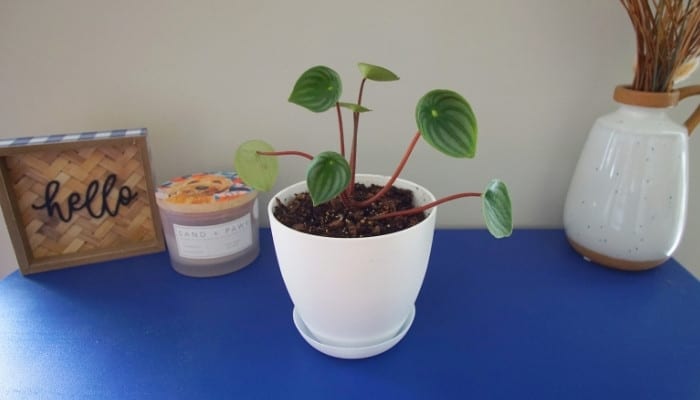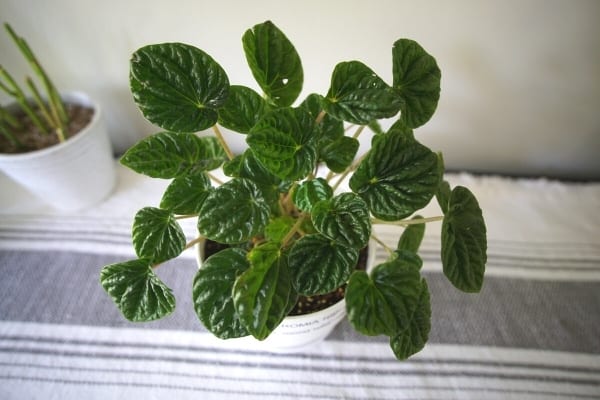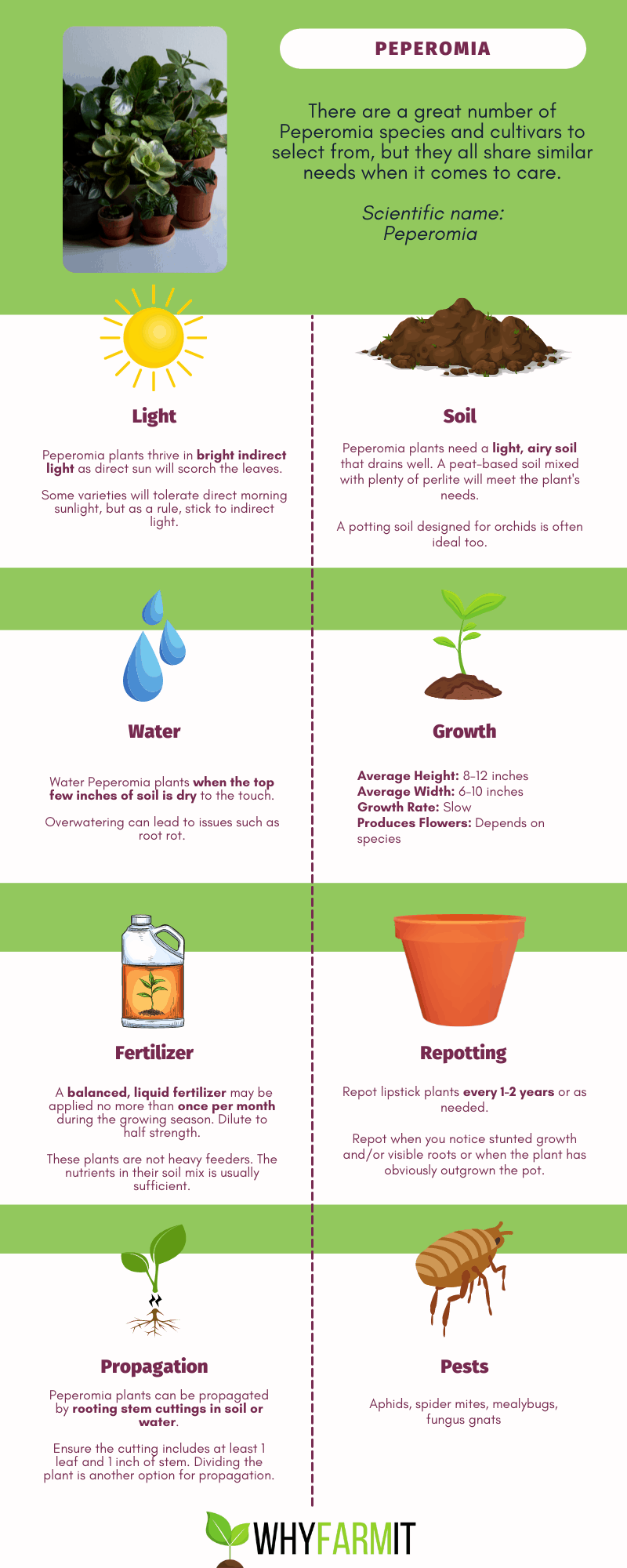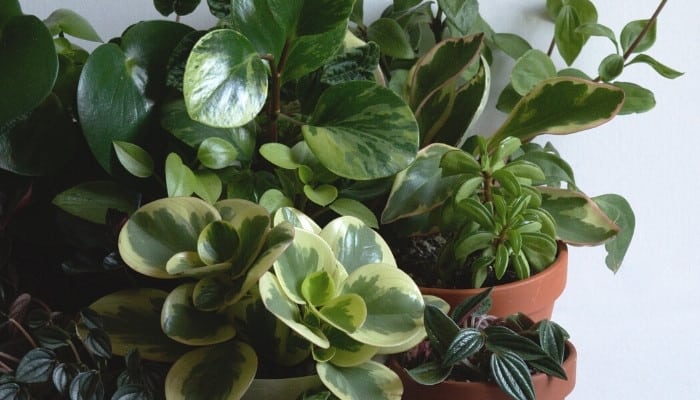If there are any difficulties in performing the rewrite, please respond with the following error message: Unable to process the request due to encountered difficulties. Peperomia plants are a versatile collection of plants with thick, fleshy leaves.
This group has a variety of shapes, sizes, colors, and textures. Regardless of their differences, they all have similar care requirements.
Are Peperomia plants easy to grow? Peperomia plants are easy to grow as long as their basic needs are met. Use a light soil mix that drains well, keep temperatures of 65-80ºF, provide plenty of bright, indirect sunlight, and water when the top few inches of soil are dry. Use a diluted fertilizer no more than once per month.
The best feature of Peperomia plants is their ability to bounce back after a period of neglect.
However, you shouldn’t have that issue because this article will tell you everything you need to know to properly care for Peperomia plants.
Keys To Growing Healthy Peperomia
These easy-going plants require the right setup and the occasional watering, but otherwise they don’t have difficult care requirements.
Potting Peperomia
When choosing a container for your Peperomia plant, it is important to find a pot with plenty of drainage holes.
Orchid pots and terra cotta pots are good options because they allow for evaporation of excess moisture from the soil.
Use an orchid potting mix when planting your Peperomia plant. This mix on Amazon is just right.
Most Peperomia plants grow as epiphytes, meaning they grow on rocks or trees. The large bark pieces in an orchid mix provide the optimal environment for Peperomia roots.
Peperomia Growing Conditions
Depending on the species, Peperomia plants need medium to bright indirect light. Avoid direct sunlight, which can scorch the leaves.
For some varieties, less severe direct sunlight in the morning can be acceptable.
If your home does not provide adequate lighting options, Peperomia plants can successfully live under artificial grow lights.
These are tropical plants, so the ideal temperature range is 65-80ºF. Some species may be okay with slightly cooler or warmer temperatures.
Peperomia plants love high humidity.
To increase the humidity around the plants, use a pebble tray with water (see how to make one easily here) or run a humidifier, like this ultra-quiet model.
Watering Peperomia
Peperomia plants do better when they are slightly drier compared to too wet. The roots are susceptible to root rot, which commonly occurs due to overwatering.
Before watering, always check the top of the soil with your finger. The top couple inches of soil should be completely dry before watering.
Peperomia Fertilization Guidelines

Peperomia plants are slow growers, and they rarely need added fertilizer. Typically, the nutrients found in the soil mixture are enough for the plant to survive.
If your specific plant looks like it would benefit from some added nutrients, use a liquid houseplant fertilizer as needed. This organic option is gentle yet effective.
Cut the fertilizer to half dilution to avoid giving the plants fertilizer burn.
Pruning Peperomia
Some Peperomia plants have a tendency to grow sparse and leggy, but pruning can help give them a more desirable shape.
It is best to wait until the beginning of the growing season (spring) to prune so the plant can quickly heal and put out new foliage.
If you’d like a bushier Peperomia plant, you can “pinch” the new growth when the plant is young.
Using your fingers or sterile scissors, remove the first set of leaves from each stem, this will encourage the plant to branch out and create a fuller shape.
Repotting Peperomia
Since Peperomia plants grow so slowly, you will not need to repot frequently. Look for roots growing out the drainage holes as your sign to repot.
Peperomia plants prefer to be slightly root bound, so you should only go up one pot size when repotting.
This will also make sure that there is not excess soil holding onto too much moisture for the size of the plant.
Popular Peperomia Varieties

- Watermelon Peperomia (Peperomia argyreia) is a small variety that has striped leaves resembling the rind of a watermelon.
- Chinese Money Plant (Peperomia polybotrya) has glossy, raindrop-shaped leaves, and it is one of the varieties that occasionally flowers indoors.
- Peperomia Frost (Peperomia obtusifolia) is a commonly seen variety that has beautiful variegated cultivars.
- String of Turtles (Peperomia prostrata) has gorgeous trailing vines with small, mottled leaves that resemble turtle shells.
- Red Ripple Peperomia (Peperomia caperata ‘Red Ripple’) has deep red, ruffled leaves and can handle lower light conditions.
- Emerald Ripple Peperomia (Peperomia caperata ‘Emerald Ripple’) has deep-green leaves, purplish stems, and arrow-like flowers.
Peperomia Propagation
It is best to propagate Peperomia plants during the growing season when the plant has plenty of light and resources to grow.
Take a stem cutting that includes at least one leaf and an inch of stem.
You can propagate in water by placing the end of the cutting in water and waiting for roots to form.
Soil propagation is also a good option. Just plant your cutting as normal, and keep the moisture high while the roots are forming.
Related Questions:
Can Peperomia Get Big?
Some varieties of Peperomia remain under 8 inches tall while other varieties can grow to be over 2 feet tall.
Do Peperomia Plants Have Flowers?
Peperomia plants that are grown outdoors (they are hardy to Zone 10) always flower. It is less common for indoor Peperomia plants to flower.
If the plant does flower, it produces tiny off-white flowers on multiple flower stalks.
Conclusion
You could fill your home with only Peperomia plants and have a diverse and beautiful collection. These are easy-to-grow plants that don’t require much to thrive for many years.


